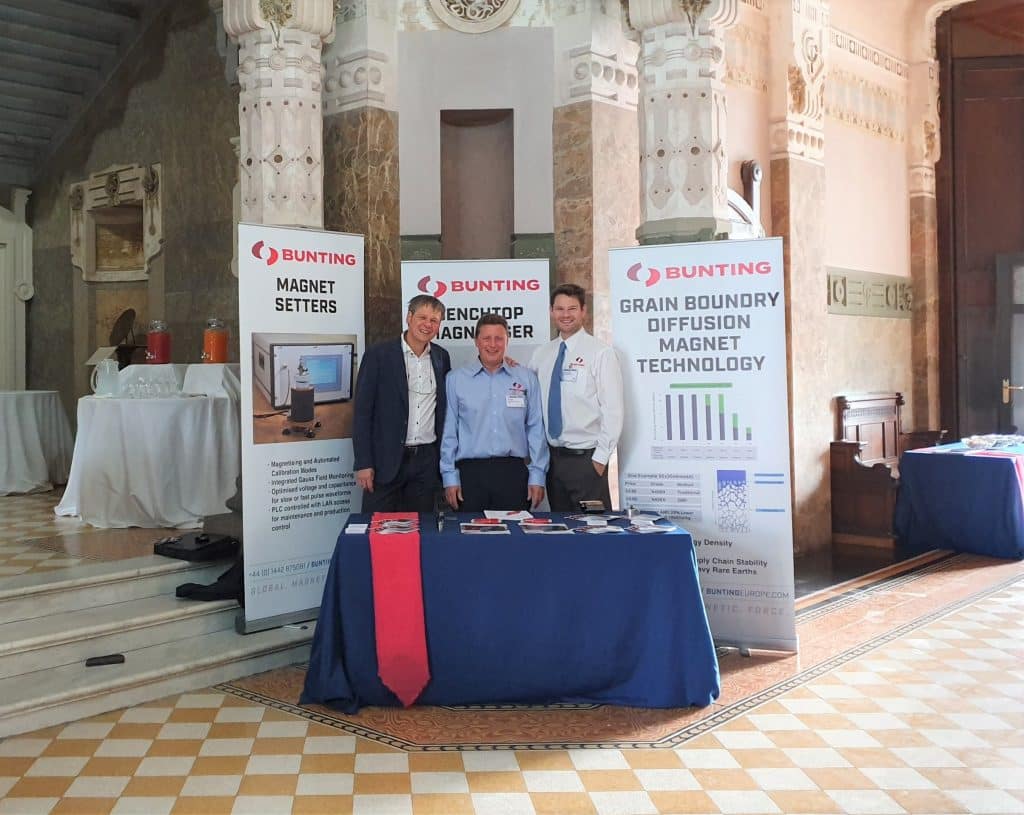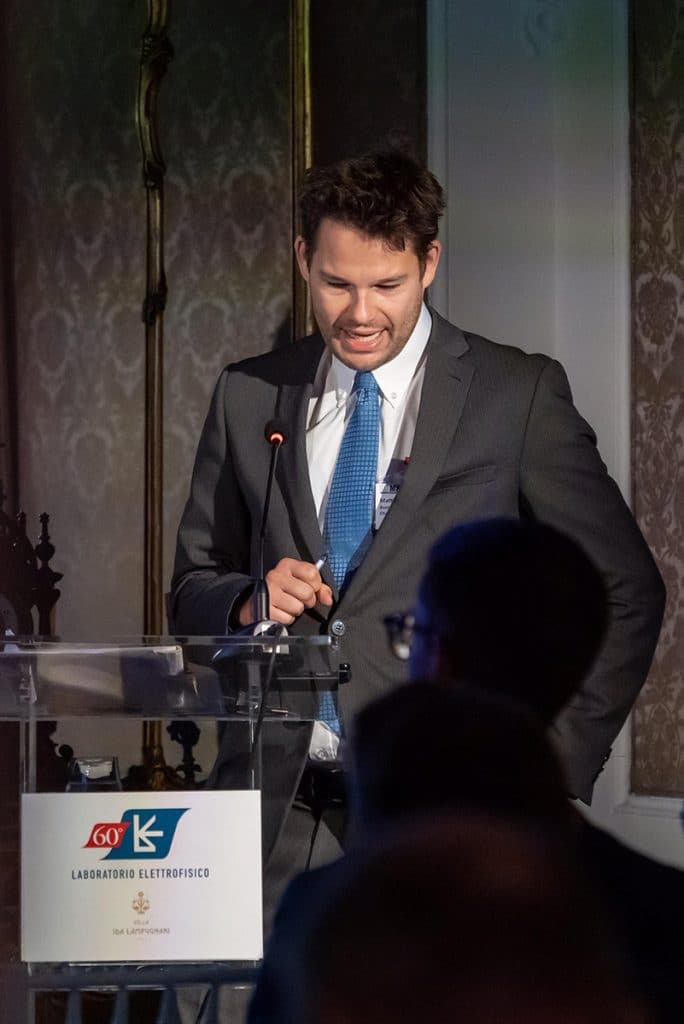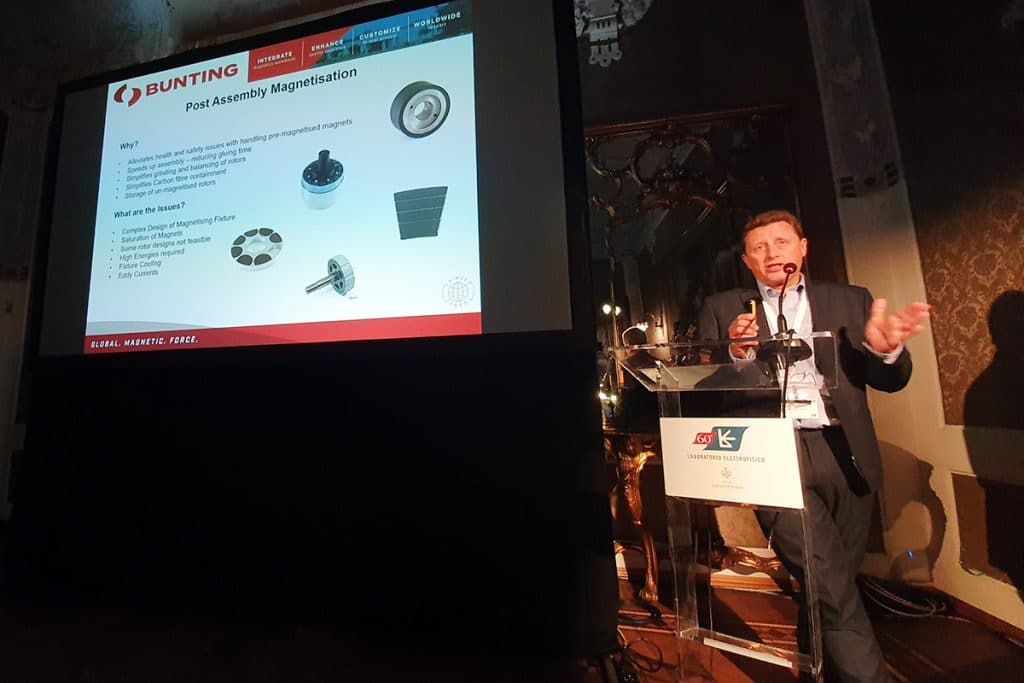Reviewing UK Magnetics Society MMA 19 Event
By Paul Fears | 14 October 2019
The UK Magnetics Society held the two-day MMA’19 conference on magnetic materials and applications in Milan, Italy on the 18th and 19th September 2019. The event was held in partnership with Laboratorio Elettrofisico as part of their 60th anniversary celebrations. The event focused on magnetic materials, their applications and related technologies, bringing the European magnetics community together to discuss the latest developments. Our Technical Product Manager for Magnetic Assemblies, Matthew Swallow, was one of the three co-chairs and, in this blog, reviews day one of the event.

Day 1 of The MMA 2019 Conference
“The UK Magnetics Society held its latest Magnetic Materials and Application event in perhaps its grandest location to date, thanks in no small part to the efforts of Laboratorio Electrofisico in celebration for their 60 years of trading. In an unusual coincidence it is also Bunting’s 60th anniversary
So with a beautiful Liberty Villa as our venue for the next 2 days the UK MagSoc Chair Jeremy Thompkins opened the event and handed over to Nick Simpson of Bristol University to summarise the European value of the magnetics sector. It was great to see so many people from the European community attending a UK MagSoc event.
The first talk was from Federico of Laboratorio Elettrofiscio, focusing on the energy efficiency considerations of magnetising systems. As all the energy discharged into a coil is lost as heat and that heat has to be removed from the system it is critical that a careful balance of energy in and out is maintained. As fixtures change their behaviour when warm maintaining a constant fixture temperature is imperative. With the introduction of 3D printing technologies that are employed by Laboratorio Elettrofiscio more complex winding is now possible with more rectangular wire and hence the fill factor is improved and the energy usage is reduced.
Our second and most passionate speaker was Badri from Grundfos. Grundfos’ owners have taken the decision to apply their personal goals to their business goals and they are committed to controlling the production all of their materials but particularly the magnets within the systems to prevent excessive damage to the Earth and to make the materials that we have go further for longer. This is a decision that has cost them, simply in terms of employing people like Badri, but also in terms of their end of life recycling program. Nevertheless, they believe that this is the right business model for them and their customers and they are committed to standardising the rare earth manufacturing route, making it more transparent and secure. Badri asked “Is it enough to be efficient” and went on to talk about the massive strides made in the last 20 years by reducing energy usage by 83% but a similar reduction in the next 20 years is only a 10% improvement so other areas need to be looked at for total system savings, hence the lifecycle management process. For those wanted to be involved with this they are introducing ISO/TC 298 which you can google to find out more information on.

Our most controversial speaker Govind from Laboratorio Elettrofiscio then took stage to talk about modelling of isotropic elements within what is normally assumed to be a fully anisotropic magnet. This is mainly focused on a ferrite magnet as during production there are isotropic regions that must exist because real world testing does not match with magnets that are modelled as being 100% anisotropic. His goal was to try to quantify the isotropic regions and come up with a model that would simulate them to balance test data with modelled data. However this approach was challenged in great detail by the audience and there were further discussions held over the course of the two day event. It was great to see a talk getting so much reaction from the crowd!
After an excellent Lunch we were treated to a rare insight into some high technology that keeps Vac at the head of the sintered NdFeB market. I had personally previously looked at the N55SH grade with wonder and scepticism, but Chris’s talk shone light on their technical success. With the theoretical limit of NdFeB being approached what can be done to continue to push the boundary of this material. Terbium is better at increasing coercivity than Dysprosium (Dy), but at an increased cost and is a potential material for the future and this can be grain boundary diffused in the same way as Dy but under slightly different processing conditions. The key to Vac’s success is that they are able to combine GBD and grain size control to get to the N55SH grades, so prized by the high end motorsport users.
Following on from this Jurgen of Fraunhofer IWKS offered a different material route. Not intended for high end applications but to try to bridge the gap between low cost ferrite and high cost high energy neodymium. If a Lanthanum (La) or Cerium (Ce) magnet could be made using $8 raw materials rather than $60 to make a 35MGOe magnet, then this would change the face of magnet usage worldwide. This is a significant part of the Novamag development project and a piece of work I am very interested in following.
The second Novamag talk was from Jose Manuel who described the goals of the Novamag project as to “design and Predict theoretically new phases and microstructures for production and test. Concentrating on (Rare Earth) (Iron) (X) combinations. Mainly focusing on La and Ce as in the previous discussion. The third Novamag talk from Heike Herper was perhaps the most theoretical of all the talks of the day and really drilled down into the atomic structure of the magnets and the impact of this on the phases of the metallic compounds created. Of all the thousands of hours of computation and analysis, five contenders have emerged as possible new magnet materials. Sadly, they still need much research but the team is hopeful that this will yield an inter magnetic strength material to utilise some of the cheaper and abundant rare earth materials.
After a well needed coffee break, Thomas Schrefi kicked us back off with a look at how to use modelling systems at the different levels of analysis. From Heisenberg at 10^-9 to FEA at 10^-6 and Maxwell Equations at 10^-3 for looking at the atomic structure, the metallic structure and then the properties respectively. Using these three analysis tools allows us to infer the bulk properties from the microstructure using computer analysis and looking for an output on coercivity. Depending on the coercivity output will depend on whether that microstructure warrants further investigation.
Dimitris Niarchos of the National Centre for Scientific Research “Demokritos” is keen to exploit the fact that Nickel and Iron are two of the most abundant materials on earth and that it impossible to replace two of the Cobalt parts in Sm1Co5 to produce SmFeCo3Ni and greatly reduce the cost. The massive data analysis required was given a boost by the work on the human genome project and analysis like theirs is now possible. They have also borrowed from the metallic combination sciences to use deposition technology in the opposite way it is normally used. By trying to create different ratios of deposition rather than a homogenous blend they are able to generate 100 different blends in a single pass and analyse more easily. By taking Iron and Cobalt (a magnet with the highest magnetic moment) and depositing in different blends the best performance can be found. A similar approach was used to find Nd1Fe12Nx which seems to have a similar Br to NdFeB and coercivity to match SmCo. Very interesting for the future of magnetic materials!

Our penultimate talk of the day from Bahar Fayyazi form the Technische Universitat Darmstadt focused on a different route to analysing new potential materials. Instead of looking at the magnetic properties their team are looking at using the mechanical properties. Similar to how steel is cold rolled or hot pressed the potential magnet materials are subjected to the same mechinal processing techniques and their subsequent performance characteristics analysed. A material that was identified in this was SmCoVCu, producing 42kl/m^3. One of the challenges they have and demonstrated through a unique video is the boiling off of the Sm during the sintering phase which leaves the grain boundary and reduces the performance. This was modified by processing at 1000 deg C rather than 1150 deg C. Currently the material as a Br of around 0.7T and a 0.6THc.
Our final talk for the day came all the way from America via a Skype link up and Mark Senti promoted the use of their unique and novel MagWire for use in motors. This was one of the most eagerly awaited talks as the technology is so shrouded in mystery. Sadly, the detail so many were hoping for was kept under lock and key by the speaker, but some nuggets of information did seep through that were enough to satisfy the crowd. Having spoken to many in the audience later that night there were at least four companies keen to get an NDA with AML and look at using the material in their applications. The technology was driven from a funding round with NASA, initially looking at superconducting wire and elements of this manufacturing process have been adopted to NdFeB. It is not the strongest material available (at 38MGOe), but the versatility and application of magnetic fields during the manufacturing process make it ideal for Halbach style Surface mount rotors.”
On day 2, Chris Riley, Bunting’s Group Magnetics Engineer gave a presentation on post-assembly magnetisation.

Bunting design and manufacture a wide range of magnets magnetic assemblies. Many are bespoke for specific applications. For further information on bespoke magnet assemblies or magnet designs, please contact us via:
Phone: +44 (0) 1442 875081
Email: sales.berkhamsted@buntingmagnetics.com
Via the Bunting-Berkhamsted website for specialist magnets and magnetic assemblies
Via Bunting-eMagnets for online purchase of Magnets and Magnetic Technology



